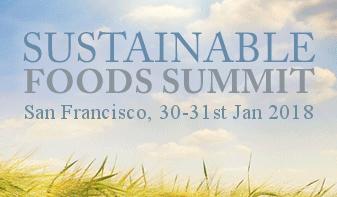Future Forecasts for Food Access and Innovation:

The 8th North American edition of the Sustainable Foods Summit took place in San Francisco in late January. Organized by Ecovia Intelligence, the Summit is a global event that assembles presentations by senior executives and other key players in the food industry: a version was held in Singapore in November 2017, and another will take place in Amsterdam in June 2018. Cooperative Grocer Network was selected as a barter partner, which enabled me to attend. This year’s theme, “New Horizons for Eco-Labels and Sustainability,” organized a broad array of topics focused on the present status and future forecasts of various global ethical product industries.
What do we anticipate in the arena of sustainable foods? How do foods earn that designation, and how are they perceived and defined by consumers—by “eaters,” as Michael Pollan would say? The Summit offered speculation concerning various scenarios in the current chaos and uncertainty—and the opportunity—of international food production and trade.
Organic and eco-labeled foods now comprise over 5 percent of the food sales in the U.S., while at the same time there is little support in the current Farm Bill for growing and meeting this customer demand. While we can expect demand to increase as tastes become more sophisticated and people experience the health benefits of “clean eating” (a current buzz phrase), we are also living in a time of rapid change and distruption to many features of traditional agriculture. Where will the sustainable food come from if we are at a loss for arable land and experienced farmers, and if those who show interest in farming have a hard time finding capital and support? What role will be played by vertical farming and other innovations?
A subtheme of the Summit involved considering lifestyle differences between baby boomers—who were early champions of sustainable foods—and millennials and other younger people who are now its most avid advocates. What does “local” mean to millennials, especially those who see themselves as international citizens? What do we make of the fact that, thanks to them, vegan eating is growing by leaps and bounds, especially as innovations take place in the development of plant-based dairy products and proteins? (The most contentiously received presentation was that of Nick Halla, chief strategy officer for Impossible Foods, developers of the Impossible Burger. One genetic engineering skeptic went so far as to say “How do you people sleep at night?” only to be reminded by another audience member that “things are not so pretty in the current meat industry.”)
The two days of meetings involved 29 sessions for all attendees, with networking lunches and product exhibitions. We were offered food samples and told the stories of some of the rapidly emerging companies in this market: AeroFarms, Wild Brine, Ocean’s Halo, Blue Evolution, Numi Tea, and Heavenly Organics. We heard from the Chief Evangelist and Head of People & Culture at Tony’s Chocolonely, a brand that is providing traceability to end slavery in the chocolate supply. There was much discussion about the evolution and impact of food labels—and the potential for consumer confusion.
Chef and author Mareya Ibrahim gave her food trends projections, noting that Americans now spend $600,000 per month on avocado toast, a restaurant item that didn’t even exist in the not-too-distant past. On the horizon are more avocados, chia seeds and goji berries, kale and micro-greens, walnuts, salmon, fermented products, green tea beverages, and ancient grains. The wide availability of inspiration on Instagram has resulted in the popularity of creating meals out of ingredients that are seasonal and fresh—home cooks assemble fruits, vegetables, carbs, and proteins into mutable meals that reduce food waste and draw inspiration from fusion cuisines. The zero-waste lifestyle trend has created a renewed interest in bulk foods.
What are the implications for food co-ops? I think it's more important than ever to pay attention to changes in food systems and marketplace trends, while supporting local variations on these themes. We have the advantage of bringing a values discussion to the table—robust conversation about food justice, the science of food, and transparency concerning GMOs and product ingredients. We are long-standing protectors of sustainable foods—it’s critical that we value our
contribution and continue to build on commonly shared potential. •







